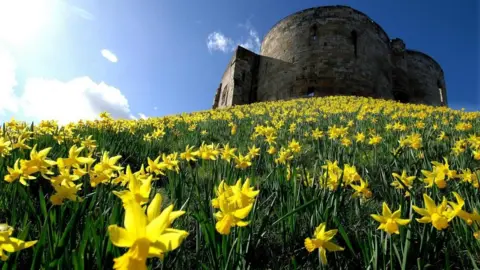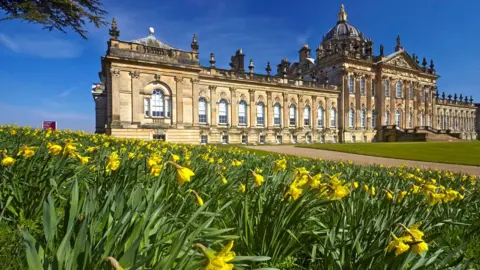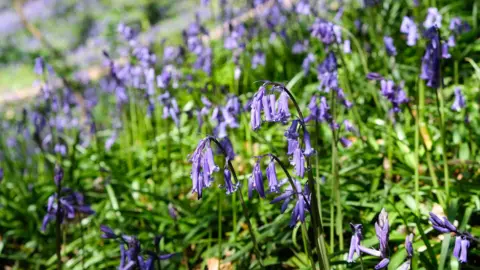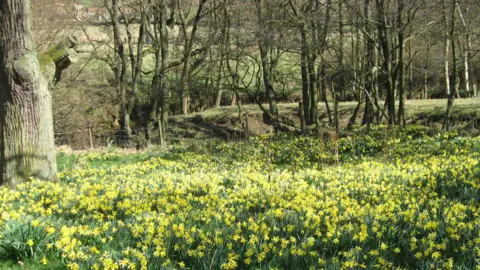BBC News, Yorkshire
 Getty Images
Getty ImagesAn unusually warm and dry march brought spring flowers and fields to bloom. And Yorkshire has some great places to see them.
According to the Met Office, England has experienced the driest marching since at least 1961 this year, with only 25% of the typical rainfall of this period.
And at Sheffield's Weston Park Meteorological Station, experts have recorded the most sunshine march since 1896.
Paul Cook, a curator of the Garden Harrower at the Royal Horticultural Society near Harrogate, says cold nights and warm days created the perfect environment for flowers.
“It was a perfect march, and for us, like many gardens, with plenty of sunlight, no rain and little wind.
“Spring flowers, all cherries and magnolia, camellia, rhodendrons, all plants that can become flowers later, or all plants that can be damaged by the weather are not just flowering, but fully flowering.”
 Getty Images
Getty ImagesThere are no extreme weather events such as storms or snow, and spring flowers are hanging longer than usual, he adds.
“The plants are covered with flowers from head to toe, which rarely occurs during this time of year.
“It's very exceptional in Spring Flowers because there's never really been a bad day to go outside and knock a flower that you slam on the floor,” he says.
Dry weather means low water, but Cook says it's not a concern at this time of year.
“We have cold clay soil, so the moisture is on the ground, so it's dry now, but it could become a problem later,” he says.
“Most plants have ample moisture in the ground during this time of year.
“While it's dry, what's for us is cracked by making sure the weeding is complete. There's mulch on the ground, splitting plants ready for summer.
“So I'll make the most of this nice weather to get out in the garden, have fun and get back some of my not-so-good spring jobs when it's cold and wet.”
 Getty Images
Getty ImagesOne of the most popular places to see spring flowers is the Farndale daffodil walk, strolling through North York Moors National Park.
Along the banks of the river, these daffodils are protected within the Ferndale Nature Reserve, founded in 1955.
Ben Jackson, area manager for the North York Moors National Park Service, says it was a very busy time with visitors to Australia.
“People look forward to the arrival of daffodils. They come from all over the place. It's a really popular place,” he says.
“The daffodils look very happy. They are very reliable. They are encouraged by the lovely and warm weather and are looking good this year.”
He agrees that the last few springs have seen changes in weather patterns.
“Last spring was cold and miserable, and this spring was the driest of 60 years, even if nothing else has changed.
“The concentration of change is prominent.”
 t eyere/geography
t eyere/geographyAlistair McLean, curator of natural sciences at Sheffield Museum, says we can be a dry year.
“Overall the past few years have been very wet,” he says.
“Overall, when you get all the rainfall all year round, you find a pattern. It's suggested for a dry year, but I've been saying it for the past three years.
“Last March there was 103mm of rain, and in March before that, there was 125mm. This was 29.7mm. It's well below average. It's about half what we'd expect in March.”
McClean manages Weston Park Weather Station, which is jointly run by Met Office and Sheffield Museums.
It records temperature, rainfall, underground temperature, sunlight time, solar radiation and wind speed and has been operating since 1896.
He says that you can see warm, dry weather as well as data.
“The grass at Weston Park weather stations is beginning to appear a little dry, which means that the grass probably doesn't grow that fast.
“We recorded 187 hours of bright sunlight in March. The normal rate is around 120 hours. Weston Park has been recording sunlight since 1896.
Where do you go to see spring flowers?
North Yorkshire
Ferndale: According to North Yorkmoor National Park, the display is said to have been planted by the medieval monks of Rievaulx Abbey.
Clifford's Tower: The last surviving section of York Castle, bringing yellow waves to the heart of York City each year, sits on a green mound covered in daffodils each spring.
West Yorkshire
Nostel: The gardens in a Georgian home near Wakefield feature spring daffodils, lively tulips and bright magenta cyclamen.
Harewood House: The grass in the west garden of Harewood is covered with daffodils in spring. The country house on the outskirts of Leeds is also known for its Rhodendron.
Lister Park: Viewed from Canal Road every April, the daffodils and crocuses in Lister Park bring color boundaries to Bradford.
South Yorkshire
Woollywood: According to Woodland Trust, Woollywood near Sheffield is one of the best Bluebell Woods in the country.
Renishaw Hall and Garden: Home to the Sitwell family for over 400 years and just south of Mosboro, Renishaw has a Bluebell from English, but is best known for its classic Italian gardens.




